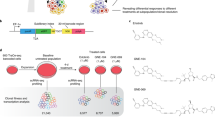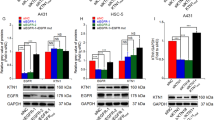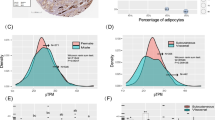Abstract
The zinc finger-containing transcription factors Egr1 (Krox24) and Egr2 (Krox20) have been implicated in the proliferation and differentiation of many cell types. Egr2 has earlier been shown to play a positive role in adipocyte differentiation, but the function of Egr1 in this context is unknown. We compared the roles of Egr1 and Egr2 in the differentiation of murine 3T3-L1 adipocytes. Egr1 protein was rapidly induced after addition of differentiation cocktail, whereas Egr2 protein initially remained low before increasing on days 1 and 2, concomitant with the disappearance of Egr1. In marked contrast to the effects of Egr2, differentiation was inhibited by ectopic expression of Egr1 and potentiated by knockdown of Egr1. The pro-adipogenic effects of Egr1 knockdown were particularly notable when isobutylmethylxanthine (IBMX) was omitted from the differentiation medium. However, knockdown of Egr1 did not affect CCAAT/enhancer binding protein (C/EBP)β protein expression or phosphorylation of CREB Ser133. Further, Egr1 did not directly affect the activity of promoters for the master adipogenic transcription factors, C/EBPα or peroxisome proliferator-activated receptor-γ2, as assessed in luciferase reporter assays. These data indicate that Egr1 and Egr2 exert opposing influences on adipocyte differentiation and that the careful regulation of both is required for maintaining appropriate levels of adipogenesis. Further, the pro-differentiation effects of IBMX involve suppression of the inhibitory influence of Egr1.
Similar content being viewed by others
Log in or create a free account to read this content
Gain free access to this article, as well as selected content from this journal and more on nature.com
or
Abbreviations
- aP2:
-
fatty-acid binding protein 2
- C/EBP:
-
CCAAT/enhancer binding protein
- DMEM:
-
Dulbecco's modified Eagle's medium
- GLUT4:
-
glucose transporter 4
- HTNC:
-
His-TAT-NLS-Cre recombinase fusion protein
- IBMX:
-
isobutylmethylxanthine
- IPTG:
-
isopropyl β-D-thiogalactoside
- KLF:
-
Kruppel-like factor
- MDI:
-
IBMX-dexamethasone and insulin
- PBS:
-
phosphate buffered saline
- PTB:
-
phosphate Tris buffer
- PPAR:
-
peroxisome proliferator-activated receptor
- SDS-PAGE:
-
sodium dodecyl sulfate polyacrylamide gel electrophoresis
- RT-PCR:
-
reverse transcriptase polymerase chain reaction
- shRNA:
-
short hairpin ribonucleic acid
References
Moitra J, Mason MM, Olive M, Krylov D, Gavrilova O, Marcus-Samuels B et al. Life without white fat: a transgenic mouse. Genes Dev 1998; 12: 3168–3181.
Petersen KF, Oral EA, Dufour S, Befroy D, Ariyan C, Yu C et al. Leptin reverses insulin resistance and hepatic steatosis in patients with severe lipodystrophy. J Clin Invest 2002; 109: 1345–1350.
Farmer SR . Transcriptional control of adipocyte formation. Cell Metab 2006; 4: 263–273.
Rosen ED, MacDougald OA . Adipocyte differentiation from the inside out. Nat Rev Mol Cell Biol 2006; 7: 885–896.
El-Jack AK, Hamm JK, Pilch PF, Farmer SR . Reconstitution of insulin-sensitive glucose transport in fibroblasts requires expression of both PPARgamma and C/EBPalpha. J Biol Chem 1999; 274: 7946–7951.
Wu Z, Rosen ED, Brun R, Hauser S, Adelmant G, Troy AE et al. Cross-regulation of C/EBP alpha and PPAR gamma controls the transcriptional pathway of adipogenesis and insulin sensitivity. Mol Cell 1999; 3: 151–158.
Fox KE, Fankell DM, Erickson PF, Majka SM, Crossno Jr JT, Klemm DJ . Depletion of cAMP-response element-binding protein/ATF1 inhibits adipogenic conversion of 3T3-L1 cells ectopically expressing CCAAT/enhancer-binding protein (C/EBP) alpha, C/EBP beta, or PPAR gamma 2. J Biol Chem 2006; 281: 40341–40353.
Klemm DJ, Leitner JW, Watson P, Nesterova A, Reusch JE, Goalstone ML et al. Insulin-induced adipocyte differentiation. Activation of CREB rescues adipogenesis from the arrest caused by inhibition of prenylation. J Biol Chem 2001; 276: 28430–28435.
Ge K, Guermah M, Yuan CX, Ito M, Wallberg AE, Spiegelman BM et al. Transcription coactivator TRAP220 is required for PPAR gamma 2-stimulated adipogenesis. Nature 2002; 417: 563–567.
Takahashi N, Kawada T, Yamamoto T, Goto T, Taimatsu A, Aoki N et al. Overexpression and ribozyme-mediated targeting of transcriptional coactivators CREB-binding protein and p300 revealed their indispensable roles in adipocyte differentiation through the regulation of peroxisome proliferator-activated receptor gamma. J Biol Chem 2002; 277: 16906–16912.
Yamauchi T, Oike Y, Kamon J, Waki H, Komeda K, Tsuchida A et al. Increased insulin sensitivity despite lipodystrophy in Crebbp heterozygous mice. Nat Genet 2002; 30: 221–226.
Rochford JJ, Semple RK, Laudes M, Boyle KB, Christodoulides C, Mulligan C et al. ETO/MTG8 is an inhibitor of C/EBPbeta activity and a regulator of early adipogenesis. Mol Cell Biol 2004; 24: 9863–9872.
Wiper-Bergeron N, Wu D, Pope L, Schild-Poulter C, Hache RJ . Stimulation of preadipocyte differentiation by steroid through targeting of an HDAC1 complex. EMBO J 2003; 22: 2135–2145.
Chen Z, Torrens JI, Anand A, Spiegelman BM, Friedman JM . Krox20 stimulates adipogenesis via C/EBPbeta-dependent and -independent mechanisms. Cell Metab 2005; 1: 93–106.
Joseph LJ, Le Beau MM, Jamieson Jr GA, Acharya S, Shows TB, Rowley JD et al. Molecular cloning, sequencing, and mapping of EGR2, a human early growth response gene encoding a protein with ‘zinc-binding finger’ structure. Proc Natl Acad Sci USA 1988; 85: 7164–7168.
Milbrandt J . A nerve growth factor-induced gene encodes a possible transcriptional regulatory factor. Science 1987; 238: 797–799.
Lau LF, Nathans D . Expression of a set of growth-related immediate early genes in BALB/c 3T3 cells: coordinate regulation with c-fos or c-myc. Proc Natl Acad Sci USA 1987; 84: 1182–1186.
Dinkel A, Warnatz K, Ledermann B, Rolink A, Zipfel PF, Burki K et al. The transcription factor early growth response 1 (Egr-1) advances differentiation of pre-B and immature B cells. J Exp Med 1998; 188: 2215–2224.
Nguyen HQ, Hoffman-Liebermann B, Liebermann DA . The zinc finger transcription factor Egr-1 is essential for and restricts differentiation along the macrophage lineage. Cell 1993; 72: 197–209.
Pignatelli M, Cortes-Canteli M, Santos A, Perez-Castillo A . Involvement of the NGFI-A gene in the differentiation of neuroblastoma cells. FEBS Lett 1999; 461: 37–42.
Lucerna M, Pomyje J, Mechtcheriakova D, Kadl A, Gruber F, Bilban M et al. Sustained expression of early growth response protein-1 blocks angiogenesis and tumor growth. Cancer Res 2006; 66: 6708–6713.
Lawrence JT, Birnbaum MJ . ADP-ribosylation factor 6 delineates separate pathways used by endothelin 1 and insulin for stimulating glucose uptake in 3T3-L1 adipocytes. Mol Cell Biol 2001; 21: 5276–5285.
Peitz M, Pfannkuche K, Rajewsky K, Edenhofer F . Ability of the hydrophobic FGF and basic TAT peptides to promote cellular uptake of recombinant Cre recombinase: a tool for efficient genetic engineering of mammalian genomes. Proc Natl Acad Sci USA 2002; 99: 4489–4494.
Reusch JE, Colton LA, Klemm DJ . CREB activation induces adipogenesis in 3T3-L1 cells. Mol Cell Biol 2000; 20: 1008–1020.
Cao Z, Umek RM, McKnight SL . Regulated expression of three C/EBP isoforms during adipose conversion of 3T3-L1 cells. Genes Dev 1991; 5: 1538–1552.
Yeh WC, Cao Z, Classon M, McKnight SL . Cascade regulation of terminal adipocyte differentiation by three members of the C/EBP family of leucine zipper proteins. Genes Dev 1995; 9: 168–181.
Christy RJ, Kaestner KH, Geiman DE, Lane MD . CCAAT/enhancer binding protein gene promoter: binding of nuclear factors during differentiation of 3T3-L1 preadipocytes. Proc Natl Acad Sci USA 1991; 88: 2593–2597.
Clarke SL, Robinson CE, Gimble JM . CAAT/enhancer binding proteins directly modulate transcription from the peroxisome proliferator-activated receptor gamma 2 promoter. Biochem Biophys Res Commun 1997; 240: 99–103.
Birsoy K, Chen Z, Friedman J . Transcriptional regulation of adipogenesis by KLF4. Cell Metab 2008; 7: 339–347.
Swirnoff AH, Milbrandt J . DNA-binding specificity of NGFI-A and related zinc finger transcription factors. Mol Cell Biol 1995; 15: 2275–2287.
Decker EL, Nehmann N, Kampen E, Eibel H, Zipfel PF, Skerka C . Early growth response proteins (EGR) and nuclear factors of activated T cells (NFAT) form heterodimers and regulate proinflammatory cytokine gene expression. Nucleic Acids Res 2003; 31: 911–921.
Dzialo-Hatton R, Milbrandt J, Hockett Jr RD, Weaver CT . Differential expression of Fas ligand in Th1 and Th2 cells is regulated by early growth response gene and NF-AT family members. J Immunol 2001; 166: 4534–4542.
Takemori H, Doi J, Katoh Y, Halder SK, Lin XZ, Horike N et al. Characterization of a proximal element in the rat preadipocyte factor-1 (Pref-1) gene promoter. Eur J Biochem 2001; 268: 205–217.
Liao H, Hyman MC, Lawrence DA, Pinsky DJ . Molecular regulation of the PAI-1 gene by hypoxia: contributions of Egr-1, HIF-1{alpha}, and C/EBP{alpha}. FASEB J 2007; 21: 935–949.
Topilko P, Levi G, Merlo G, Mantero S, Desmarquet C, Mancardi G et al. Differential regulation of the zinc finger genes Krox-20 and Krox-24 (Egr-1) suggests antagonistic roles in Schwann cells. J Neurosci Res 1997; 50: 702–712.
Collins S, Lutz MA, Zarek PE, Anders RA, Kersh GJ, Powell JD . Opposing regulation of T cell function by Egr-1/NAB2 and Egr-2/Egr-3. Eur J Immunol 2008; 38: 528–536.
Laslo P, Spooner CJ, Warmflash A, Lancki DW, Lee HJ, Sciammas R et al. Multilineage transcriptional priming and determination of alternate hematopoietic cell fates. Cell 2006; 126: 755–766.
Carter JH, Lefebvre JM, Wiest DL, Tourtellotte WG . Redundant role for early growth response transcriptional regulators in thymocyte differentiation and survival. J Immunol 2007; 178: 6796–6805.
Tang QQ, Jiang MS, Lane MD . Repression of transcription mediated by dual elements in the CCAAT/enhancer binding protein alpha gene. Proc Natl Acad Sci USA 1997; 94: 13571–13575.
Acknowledgements
We are very grateful to the Wellcome Trust for financial support for the Biological Atlas of Insulin Resistance (BAIR) program (GR066786), and to all members of the BAIR consortium for helpful discussion. We also acknowledge support from the BBSRC (project grant C20109 for SHR), MRC (studentships for SV and WPC) and European Union COST Action BM0602. We thank Dr. F Edenhofer (Institute of Reconstructive Neurobiology, University of Bonn, Germany) for the pTriEx1.1 plasmid and advice on the production of HTNC protein, Dr. MJ Birnbaum (Howard Hughes Medical Institute, PA, USA) for pLPNPX1 plasmid and Dr. Justin Rochford (University of Cambridge) for helpful discussion.
Author information
Authors and Affiliations
Corresponding author
Additional information
Edited by M Federici
Supplementary Information accompanies the paper on Cell Death and Differentiation website (http://www.nature.com/cdd)
Supplementary information
Rights and permissions
About this article
Cite this article
Boyle, K., Hadaschik, D., Virtue, S. et al. The transcription factors Egr1 and Egr2 have opposing influences on adipocyte differentiation. Cell Death Differ 16, 782–789 (2009). https://doi.org/10.1038/cdd.2009.11
Received:
Revised:
Accepted:
Published:
Issue date:
DOI: https://doi.org/10.1038/cdd.2009.11
Keywords
This article is cited by
-
Transcriptomic profiling of the telomerase transformed Mesenchymal stromal cells derived adipocytes in response to rosiglitazone
BMC Genomic Data (2022)
-
EEF1A1 transcription cofactor gene polymorphism is associated with muscle gene expression and residual feed intake in Nelore cattle
Mammalian Genome (2022)
-
Whole transcriptome RNA-seq reveals key regulatory factors involved in type 2 diabetes pathology in peripheral fat of Asian Indians
Scientific Reports (2021)
-
Co-expression network analysis predicts a key role of microRNAs in the adaptation of the porcine skeletal muscle to nutrient supply
Journal of Animal Science and Biotechnology (2020)
-
Adipogenesis and metabolic health
Nature Reviews Molecular Cell Biology (2019)



